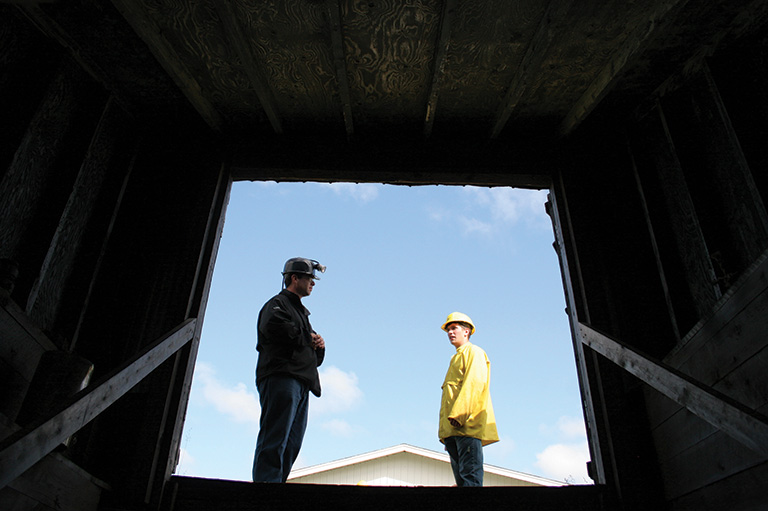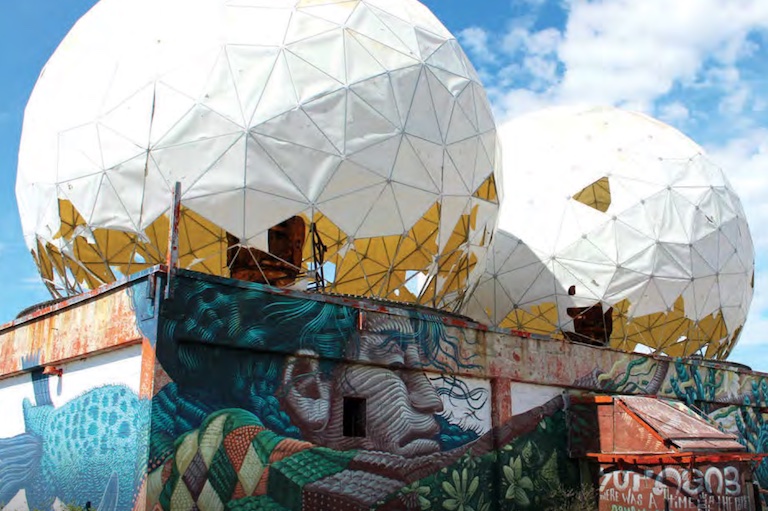New World, Old Charm
Quebec City and its world-famous Winter Carnival are synonymous with frozen fun. From its jolly snowman mascot, Bonhomme, to its snow sculpture competitions and awesome ice palace, the two-week annual event draws thousands of tourists.
However, beyond the festival lies a city steeped in history — founded more than four hundred years ago and rich in culture and architectural marvels. So if you are heading to Quebec City for Carnival — which typically runs from late January 29 early February – be sure to explore everything that the Old City of Quebec has to offer. As a guide, we present travel writer André Pelchat's guide to la Vielle Capitale.
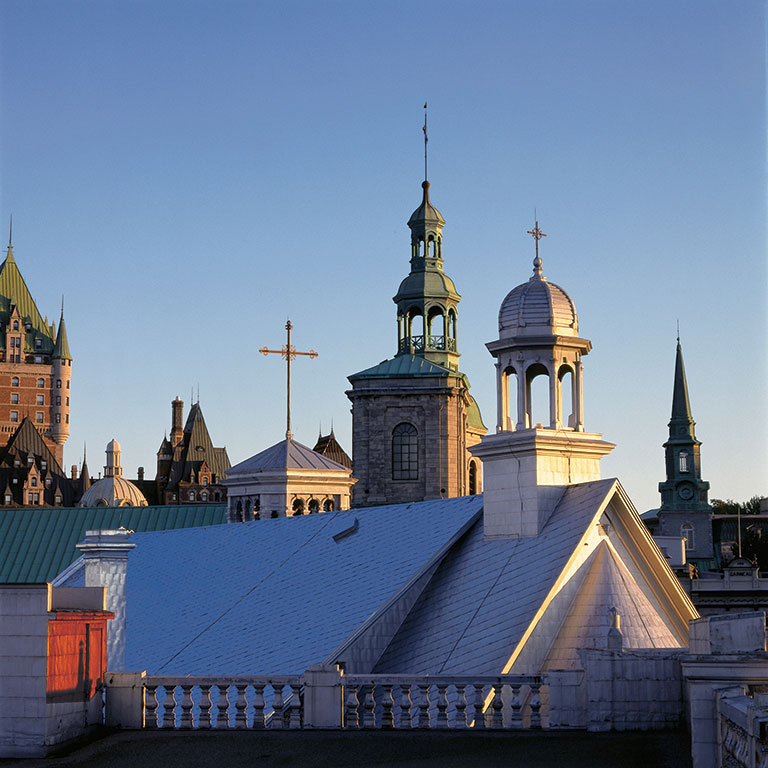
It’s not a nice thing to say about a person, but for a city it’s a compliment: Quebec City looks its age. This place has history and beauty like no other.
Towering above the St. Lawrence, the venerable capital, the very heart of French North America, is like a slice of Europe picked up and transported to the New World. With its cobblestone streets, narrow alleys, and many restaurants and small shops, the city’s four hundred years of history comes alive at every turn.
On this day, we approach la Vieille Capitale (the Old Capital) by water, crossing the mighty St. Lawrence by ferry from Lévis. The ferry departs every twenty minutes and rewards visitors with a breathtaking view of the majestic city Samuel de Champlain founded in 1608.
From Lévis’ cliffs, the eye embraces the whole historic part of Quebec’s capital city, starting with the Basse Ville (Lower Town), which lies at the bottom of the imposing rock mass that is Cap Diamant.
It was here, in 1542, that the famed French explorer Jacques Cartier thought he had found diamonds — hence the name of the cape. Unfortunately for Cartier, the diamonds turned out to be quartz.
Perched on Cap Diamant, growing closer by the minute, is the impressive Château Frontenac, said by some to be the most photographed hotel in the world.
The Château was built in 1892, just as Quebec was beginning its transformation from shipbuilding centre to tourist mecca. For Quebecers, the word mecca is especially appropriate, because, for many in the province, a visit to the capital is something of a cultural pilgrimage. Walking the streets of Quebec City — retracing the footsteps of Champlain, Montcalm, Frontenac, and the other historic heroes of Quebec — is a profoundly moving experience.
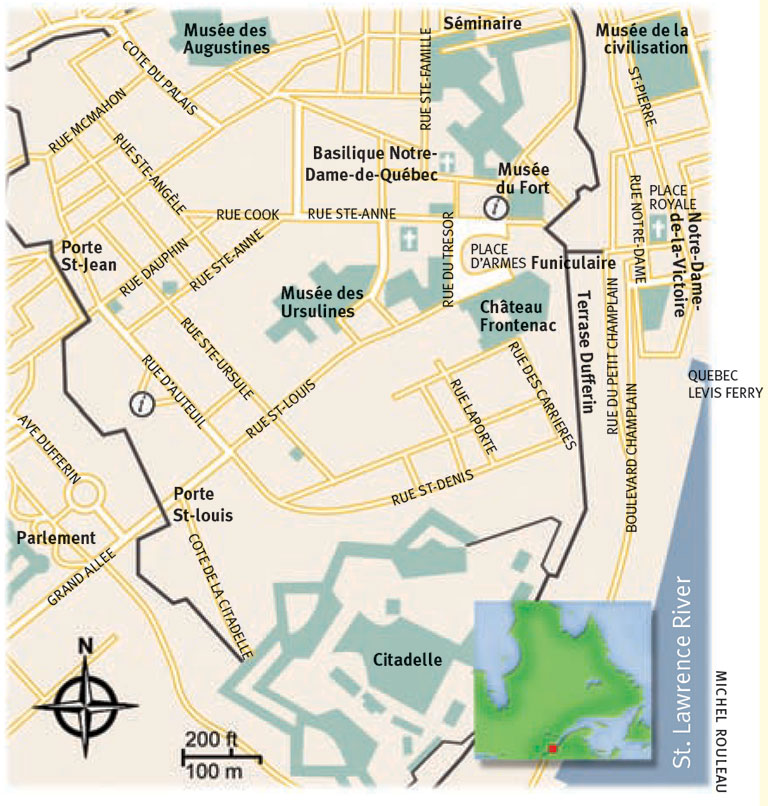
The ferry reaches the dock, and we disembark in front of the Batterie Royale. This stone redoubt, complete with cannons and surrounded by a moat, was built in 1691, but took its current appearance after improvements under one of Frontenac’s successors, in 1712. In the wake of the Conquest, it was buried under the street, only to be uncovered and rebuilt in 1977.
Behind it is Place Royale, a square that replicates the one erected there in 1686. This was the heart of Old Quebec, the original marketplace where inhabitants met to trade furs and food, and share the news of the day. Today, it’s surrounded by a collection of gorgeous stone houses, dating from the late 1600s to the early 1700s. A major restoration program in the 1980s transformed this formerly economically depressed area into a major tourist attraction. Visitors can now enjoy a museum of ancien régime architecture. Historical information on specific houses can be found at the Centre d’interprétation de la Place Royale.
A key landmark is the Notre-Dame-des-Victoires church. Built in 1688, it earned the name “Notre-Dame-de-la-Victoire” after Frontenac’s victory over Sir William Phips, the Massachusetts governor who tried to conquer Quebec in 1690. It was during this battle that Frontenac uttered what is likely the most famous sentence in the history of New France: Je vous répondrai par la bouche de mes canons (I will reply from the mouth of my cannons.)
The church’s name was altered slightly, from Our Lady of Victory to Our Lady of Victories, after British Admiral Hovenden Walker’s failed invasion in 1711.
Looking down, you can see dark lines on the cobblestones surrounding the church, which show the contours of Champlain’s original 1608 habitation. Archaeologists have found that the building was almost directly under the church. “This is where it all began,” one tour guide said, pointing at the marks with his finger.
We head to a purple-roofed house, which used to be the residence of Louis Jolliet — the explorer who discovered the Mississippi River in the 1670s. Taking the funicular, we ride the elevator up the side of the cliff to the Dufferin Terrace.
In a few moments, our journey from the Basse-Ville to the Haute-Ville is complete. Constantly occupied by musicians, jugglers, and artists, the Dufferin Terrace offers a sweeping panoramic view of the river and the surrounding low hills of the region. Far below, the brilliant blue river is alive with ships and sailboats of all sorts. Hordes of tourists pass by a display of old sepia-toned photos from the Victorian era. Even then, visitors were attracted to the romance and grandeur of the terrace walk.
In Quebec City, the community’s history is displayed in concentric circles, ever-expanding from the heart of the Old City. Outside its famous fortified walls, French architecture gives way to stately Victorian homes, a result of the British occupation of New France. The furtherafield you travel from the Old City, the more modern the buildings become, until the transformation from la Vieille Capitale to the modern capital of Quebec — with a population of more than six hundred thousand people — is complete.
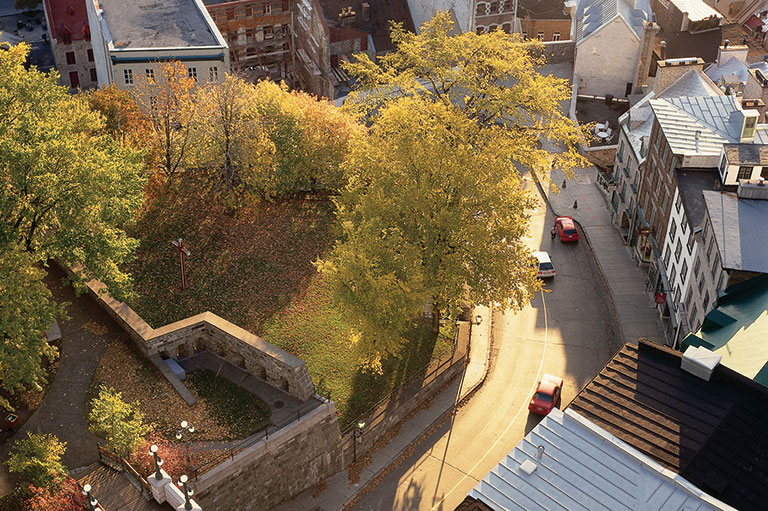
One visit is not enough to begin taking in all that is Quebec City. The museums alone are reason enough to come. Among our favourites are the Musée de Québec, on the Grande Allée, with its impressive collection of Quebec Art, and the Musée de la Civilisation, in the Basse-Ville, with its interactive displays of the history of day-to-day life.
Then there are the restaurants, the culture, the city’s many festivals, and the nightlife. Where does one begin?
In the heart of the Old City stands a gigantic bronze statue, erected in 1898, of the founder of this great city. What would Samuel de Champlain think of the modern-day version of the city he founded so many years ago?
Surrounded by this perfect blend of past and present, so full of life and charm, we’re sure he would approve.
Themes associated with this article
Advertisement

